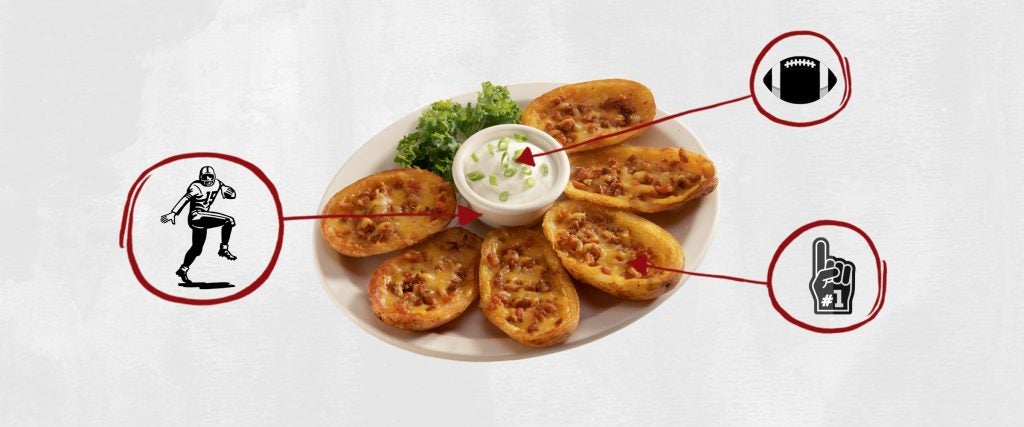Forget Thanksgiving. The most gluttonous day of the year is Super Bowl Sunday, where bowl after bowl and paper plate after paper plate is filled with finger-food bacchanalia that would make even the mad genius responsible for the TGI Friday’s appetizer selection blush (and certainly the ancient Romans). And so, all week leading up to game day, we’ll be offering up our own menu of scientific investigations, origin stories and majestic feats of snacking that not even the biggest sporting event of the year can top. Read all of the stories here.
If you’re a child of the 1980s like I am, the first thing that comes to mind when you think about potato skins might be the jingle from the Keebler Tato Skins commercial. If that’s the case, I hope that you’re as embarrassed as I am by that fact, because Keebler’s offering has almost nothing in common with real potato skins, save for the primary ingredient. Real potato skins can’t be effortlessly extracted from a polyethylene bag like so many other snacks, so if you want to serve up a proper rendition of this spud-based bonanza, you’re going to have to do so with some love, care and attention.
Fortunately, there are several easily replicated recipes for potato skins online, the majority of which have the same ingredients, and all of those ingredients are relatively inexpensive. They do take a decent amount of prep time — i.e., you can’t just pop them into the oven like pizza rolls or microwave them like Super Pretzels. That’s why, if you ask me, your optimal choice is to make dozens of them before you sit down to watch the game, lest you be called away to do more chopping and slicing during Eminem’s halftime appearance.

Ingredients
Russet potatoes: The russet potato is the go-to potato for most forms of french fries, from McDonald’s to Five Guys. In fact, what we popularly regard as Idaho potatoes are, in fact, russets.
Extra virgin olive oil: Widely regarded as the healthiest form of olive oil, extra virgin olive oil is credited with reducing inflammation, lowering blood pressure and containing valuable antioxidants.
Salt: Like almost any other snack item starring a potato, these skins are expected to have salt in them. Fortunately, if you make the skins yourself, you can distribute the salt so that you don’t end up with a hypertension-inducing dose of sodium running through your blood. By the way, it’s important to keep in mind that just a teaspoon of salt contains the recommended level of salt for an entire day; a tablespoon contains three times as much.
Black Pepper: Plain old black pepper, which isn’t as plain and ordinary as you might suspect. Black pepper has antioxidant and anti-inflammatory properties, and it potentially inhibits the ability of cancer cells to resist the drugs that attempt to combat them.
Bacon: Everyone’s favorite form of fatty, salt-cured pork.
Cheddar Cheese: Originating in the Somerset region of England, cheddar ultimately became the world’s most popular cheese variety, and if it weren’t for pizza, it would easily surpass mozzarella as the most widely produced cheese in the U.S. The “cheddaring” of cheese refers to the additional production step of kneading the curd with salt, cutting it into cubes to drain the whey and then stacking and turning it.
Sour Cream: You can actually make your own sour cream by mixing a wide variety of things with milk, heavy cream and something else to create a bacterial culture. This can be vinegar, lemon juice, yogurt or whatever else you like. However, if you buy your sour cream from the grocery store, it’s likely to consist of cultured cream, skim milk and vitamin A palmitate, which is a form of vitamin A extracted from animal products.
Green Onions: These are the exact same thing as scallions, which differ from other onions because the leaves are used as the consumed vegetable rather than the root.
The Verdict
If you’re smart about this, you might actually be able to smash down sufficient skins during the Super Bowl and still call it healthy… sort of.
Obviously, we’re talking about a homemade item, so the burden for maximizing healthiness falls to you. As long as you don’t get too carried away with the salt, you could enjoy eight to 12 potato skins throughout the game, consume in the ballpark of 700 to 1,100 calories and leave the party knowing that you took in some solid amounts of vitamin C, calcium and iron.
I’d like to see a Keebler Elf try to do that.

